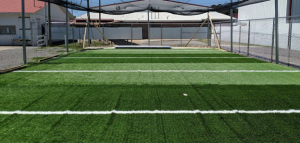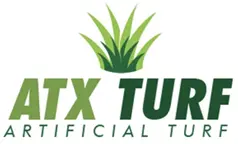Artificial Turf Grain: What direction should turf be laid?

Batting Cage with Alternating Pile Direction
Published, August 22, 2022
The fibers in artificial turf will lean in one direction. This is referred to as Pile Direction, or the “Grain.” In natural grass, the sun keeps grass blades standing up straight, but artificial turf blades, typically made from polypropylene or nylon, will lean “or” fall in one direction which is dictated in the manufacturing process when the fibers are tufted into the backing. While it is easy to see the grain of taller athletic field and lawn turfs, the grain of “flat” turfs and putting green turf can be much more subtle and not visible to the naked eye.
The direction or “grain,” of the turf is important to understand for both aesthetic and performance reasons. When looking into the grain, turf appears darker and richer. When the grain is facing away from the observer, it appears lighter and shinier, as the light reflects off the top of the blades.
On baseball fields, typically the outfield turf will be laid such that the grain faces homeplate so that most people behind the plate see the turf as being darker and richer. On a football field, the turf rolls in the “belly” of the field are laid so that the grain faces the home side of the stadium. The sideline rolls run perpendicular to the belly rolls, which is why sidelines
Artificial Grass for lawns and athletic field turf, often have 1 inch to 2.5 inch pile heights, and subsequently, it is easy to see the direction of the grain with the naked eye. On “flat” turf, such as putting green turfs with a tighter nap, its difficult to see the grain direction up close. This is often the cause of mis-laid turf, as the rolls will look the same up close when laid in a different direction, but from a distance, the subtlety of the grain direction is amplified and can appear a very different shade of green. This is often the case in carpet, as well.
There is an old trick in the carpet installation business that you can easily use to tell the actual direction of the grain in the flatter turfs. Take a piece of notebook paper and lay it on the turf. Take a number 2 pencil and place it in the middle of the paper with the eraser and lead pointed towards the ends of the rolls of turf. Take the palm of your hand and quickly roll the pencil back and forth on the piece of paper, and the paper will move or “shimmie” towards one end of the roll. Whichever direction the paper moves, is the direction of the grain. Once you have all your turf rolls laid out, do this on each roll to ensure the paper moves in the same direction each time.
The direction of the grain can effect the roll of a golf ball, but can also dictate the speed of a rolling baseball or soccer ball. Call your representative at ATXTurf today, to discuss what’s best for your application. 866-428-2809

0 Comments